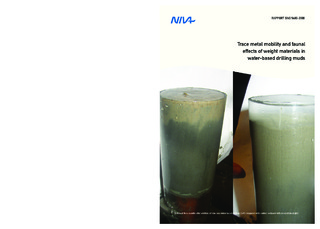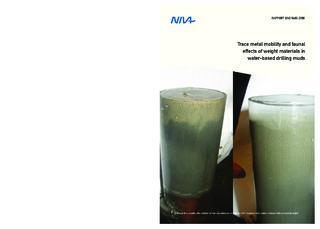| dc.contributor.author | Schaanning, M. | nb_NO |
| dc.contributor.author | Trannum, H. | nb_NO |
| dc.contributor.author | Holth, T. | nb_NO |
| dc.contributor.author | Øxnevad, S. | nb_NO |
| dc.contributor.other | Schaanning, M. - Project manager | nb_NO |
| dc.date.accessioned | 2014-08-01T10:52:40Z | |
| dc.date.available | 2014-08-01T10:52:40Z | |
| dc.date.issued | 2009 | nb_NO |
| dc.identifier | 5680 | nb_NO |
| dc.identifier.isbn | 978-82-577-5415-0 | nb_NO |
| dc.identifier.issn | 1894-7948 | nb_NO |
| dc.identifier.uri | http://hdl.handle.net/11250/214252 | |
| dc.description | Årsliste 2008 | nb_NO |
| dc.description.abstract | Ilmenite and barite minerals are alternative weight materials in water-based drilling muds for off-shore drilling operations. After use mud remnants may be discharged from the platforms and end up in cuttings deposits on the seabed. In order to assess potential environmental benefits from substitution of barite with ilmenite in drilling muds, a mesocosm experiment was performed in which 9 mm thick layers of various weight mineral and cuttings samples were added on the sediment surface of box core samples transferred from 35 m depth in the Oslofjord. One barite mineral sample was “markedly” contaminated with cadmium, copper, lead and zinc and the study showed increased release of the same metals to the overlying seawater. Slightly reduced number of species indicated that such elevated release of metals may harm sensitive macrobenthic species. The ilmenite mineral sample was “markedly” polluted with nickel and chromium, but only nickel was released to the overlying water at rates significantly higher than the release from control sediments and no effects on benthic organisms were observed in this treatment. All treatments with water-based cuttings showed oxygen depletion and lowered redox potentials within the sediment surface, and significant negative effects on the benthic communities. The release of metals were, however, lower in the cuttings treatments than in the mineral treatments as might be expected both from lower metal concentrations and the more reducing pore water conditions. The study has shown that substitution of contaminated barite with less contaminated barite or ilmenite may lead to less release of heavy metals such as cadmium, copper, lead and zinc from cuttings discharged off-shore. Increased discharge of ilmenite will however, increase the release of nickel to the off-shore environment. | nb_NO |
| dc.description.sponsorship | M-I SWACO | nb_NO |
| dc.publisher | Norsk institutt for vannforskning | nb_NO |
| dc.relation.ispartofseries | NIVA-rapport;5680 | nb_NO |
| dc.rights | Navngivelse-IkkeKommersiell-DelPåSammeVilkår 3.0 Norge | nb_NO |
| dc.rights.uri | http://creativecommons.org/licenses/by-nc-sa/3.0/no/ | nb_NO |
| dc.subject | miljøgifter - marint | nb_NO |
| dc.title | Trace metal mobility and faunal effects of weight materials in water-based drilling muds | nb_NO |
| dc.type | Research report | nb_NO |
| dc.rights.holder | Norsk institutt for vannforskning/Norwegian institute for water research | nb_NO |
| dc.subject.nsi | VDP::Matematikk og naturvitenskap: 400 | nb_NO |
| dc.source.pagenumber | 54 | nb_NO |
| dc.subject.keyword | borekaks | nb_NO |
| dc.subject.keyword | marine sedimenter | nb_NO |
| dc.subject.keyword | utlekking metaller | nb_NO |
| dc.subject.keyword | bunnfauna | nb_NO |
| dc.subject.keyword | drilling mud | nb_NO |
| dc.subject.keyword | marine sediments | nb_NO |
| dc.subject.keyword | metal fluxes | nb_NO |
| dc.subject.keyword | benthic fauna | nb_NO |
| dc.relation.project | O-26152 | nb_NO |


